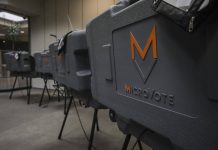NORTH VERNON — Training to show Jennings County firefighters how to walk into a fiery blaze and survive began recently at the North Vernon Fire Department.
Fire Chief Mike Cole brought a special live-fire training device from the state Homeland Security office to the city to train career firefighters and volunteers on July 28.
The Mobile Live Fire Training Trailer is 48 feet long, 8 feet wide and 10 feet tall. It can be extended to 18-feet long and an upstairs can be added, but the North Vernon Fire Department elected to use the basic structure.
On the outside, the MLFTT looks like a red semi-trailer or mobile home but, the inside is constructed like a large, furnished home.
Using electronic controls, a trainer remains on the outside and directs fire and smoke throughout the MLFTT.
Flames shoot through the rooms and climb up the walls as in a real house fire while firefighters move through the space, carrying their equipment and completing assigned tasks such as rescuing a person.
“It absolutely is good training. It’s about as realistic as you can get and still be in a controlled environment,” veteran volunteer firefighter Cory Tichenor said.
A new volunteer firefighter, Cristie Gilpin, drank water and tried to cool down after she completed her training in the MLFTT.
“It was extremely hot and very, very exausting,” said Gilpin, who has not yet experienced working in a burning structure. “It felt like my knees were burning. I think it helped me get over my fear of the heat.”
Cole said that the turnout suits firefighters wear protect them from burning, but the suits are heavy. With their helmets, boots, oxygen tanks and other equipment, firefighters carrying about 75 pounds in an environment that ranges from 1,100 to 3,000 degrees in temperature.
“They can only stay in a very few minutes, so every minute and every movement counts,” Cole said.
North Vernon Fire Department Lt. Aaron Poole said every firefighter must learn search patterns and team movements.
“It’s when someone goes off pattern that they are likely to get lost and that does happen. That’s why this kind of training is so important,” Poole said.
The MLFTT was created to provide a realistic, controlled environment to allow firefighters to perform the majority of their trained skills, including search and rescue, ventilation, fire attack and ladder work, said Amber Kent, senior public affairs officer for the state Homeland Security office.
The MLFTT cost $500,000 to build, and firefighter training 10 years ago. More than 100,000 firefighters have been trained in the MLFTT, Kent said.




